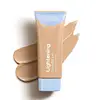Wardah Lightening Fresh BB Tint SPF 32 Versus Azarine Cicamide Barrier Sunscreen Moisturiser SPF 35 PA+++
What's inside
What's inside
 Key Ingredients
Key Ingredients

 Benefits
Benefits

 Concerns
Concerns

 Ingredients Side-by-side
Ingredients Side-by-side

Water
Skin ConditioningEthylhexyl Methoxycinnamate
UV AbsorberCyclopentasiloxane
EmollientButylene Glycol
HumectantIsododecane
EmollientCaprylyl Methicone
Skin ConditioningNiacinamide
SmoothingDimethicone
EmollientEthylhexyl Palmitate
EmollientLauryl PEG-9 Polydimethylsiloxyethyl Dimethicone
Skin ConditioningPEG-10 Dimethicone
Skin ConditioningTitanium Dioxide
Cosmetic ColorantStearic Acid
CleansingDimethicone Crosspolymer
Emulsion StabilisingSodium Chloride
MaskingTriethylhexanoin
MaskingZinc Oxide
Cosmetic ColorantDisteardimonium Hectorite
StabilisingSilica
AbrasiveCyclohexasiloxane
EmollientPropylene Glycol
HumectantPolyhydroxystearic Acid
EmulsifyingPhenoxyethanol
PreservativeDimethicone/Vinyl Dimethicone Crosspolymer
Skin ConditioningAloe Barbadensis Leaf Extract
EmollientPropylene Carbonate
SolventTriethoxycaprylylsilane
Aluminum Hydroxide
EmollientNylon-12
Tocopheryl Acetate
AntioxidantGlycerin
HumectantAllantoin
Skin ConditioningAscorbyl Tetraisopalmitate
AntioxidantEthylhexylglycerin
Skin ConditioningDisodium EDTA
Sodium Hyaluronate
HumectantBHT
AntioxidantTrimethylsiloxysilicate
EmollientGlycyrrhiza Glabra Root Extract
BleachingCarbomer
Emulsion StabilisingPolysorbate 20
EmulsifyingPotassium Sorbate
PreservativeSodium Benzoate
MaskingTocopherol
AntioxidantPalmitoyl Pentapeptide-4
Skin ConditioningCI 77891
Cosmetic ColorantCI 77492
Cosmetic ColorantCI 77491
Cosmetic ColorantCI 77499
Cosmetic ColorantWater, Ethylhexyl Methoxycinnamate, Cyclopentasiloxane, Butylene Glycol, Isododecane, Caprylyl Methicone, Niacinamide, Dimethicone, Ethylhexyl Palmitate, Lauryl PEG-9 Polydimethylsiloxyethyl Dimethicone, PEG-10 Dimethicone, Titanium Dioxide, Stearic Acid, Dimethicone Crosspolymer, Sodium Chloride, Triethylhexanoin, Zinc Oxide, Disteardimonium Hectorite, Silica, Cyclohexasiloxane, Propylene Glycol, Polyhydroxystearic Acid, Phenoxyethanol, Dimethicone/Vinyl Dimethicone Crosspolymer, Aloe Barbadensis Leaf Extract, Propylene Carbonate, Triethoxycaprylylsilane, Aluminum Hydroxide, Nylon-12, Tocopheryl Acetate, Glycerin, Allantoin, Ascorbyl Tetraisopalmitate, Ethylhexylglycerin, Disodium EDTA, Sodium Hyaluronate, BHT, Trimethylsiloxysilicate, Glycyrrhiza Glabra Root Extract, Carbomer, Polysorbate 20, Potassium Sorbate, Sodium Benzoate, Tocopherol, Palmitoyl Pentapeptide-4, CI 77891, CI 77492, CI 77491, CI 77499
Water
Skin ConditioningGlycerin
HumectantEthylhexyl Methoxycinnamate
UV AbsorberButyl Methoxydibenzoylmethane
UV AbsorberCeteareth-25
CleansingCentella Asiatica Extract
CleansingAcrylates Crosspolymer
AbsorbentInulin Lauryl Carbamate
Emulsion StabilisingCetyl Alcohol
EmollientBehenic Acid
CleansingEthylhexyl Triazone
UV AbsorberChlorphenesin
AntimicrobialSqualane
EmollientCholesterol
EmollientSodium Hyaluronate
HumectantCeramide NP
Skin ConditioningCeramide Ns
Skin ConditioningCeramide Eos
Skin ConditioningCeramide EOP
Skin ConditioningCeramide AP
Skin ConditioningEctoin
Skin ConditioningPhenoxyethanol
PreservativeCaprooyl Phytosphingosine
Skin ConditioningCaprooyl Sphingosine
Skin ConditioningOctocrylene
UV AbsorberSodium Surfactin
CleansingWater, Glycerin, Ethylhexyl Methoxycinnamate, Butyl Methoxydibenzoylmethane, Ceteareth-25, Centella Asiatica Extract, Acrylates Crosspolymer, Inulin Lauryl Carbamate, Cetyl Alcohol, Behenic Acid, Ethylhexyl Triazone, Chlorphenesin, Squalane, Cholesterol, Sodium Hyaluronate, Ceramide NP, Ceramide Ns, Ceramide Eos, Ceramide EOP, Ceramide AP, Ectoin, Phenoxyethanol, Caprooyl Phytosphingosine, Caprooyl Sphingosine, Octocrylene, Sodium Surfactin
Ingredients Explained
These ingredients are found in both products.
Ingredients higher up in an ingredient list are typically present in a larger amount.
Ethylhexyl Methoxycinnamate is an organic compound that provides UVB protection. It often goes by the more common name of octinoxate. It is created from methoxycinnamic acid and 2-ethylhexanol.
Ethylhexyl Methoxycinnamate absorbs UVB rays with wavelengths between 280-320 nm. UV absorbers protect your skin by using chemical reactions to convert UV rays into heat and energy.
UVB (290-320 nm) rays emit more energy than UVA rays. They are capable of damaging DNA, causing sunburns and are thought to be linked to skin cancer.
The state of Hawaii has banned sunscreens containing octinoxate due to its potential impact on coral reefs. More research is needed to bridge gaps in this research. The European Union allows higher levels of octinoxate in sunscreens than the US and Australia.
Ethylhexyl Methoxycinnamate is oil soluble. It is not stable and may lose efficacy when exposed to sunlight.
Learn more about Ethylhexyl MethoxycinnamateGlycerin is already naturally found in your skin. It helps moisturize and protect your skin.
A study from 2016 found glycerin to be more effective as a humectant than AHAs and hyaluronic acid.
As a humectant, it helps the skin stay hydrated by pulling moisture to your skin. The low molecular weight of glycerin allows it to pull moisture into the deeper layers of your skin.
Hydrated skin improves your skin barrier; Your skin barrier helps protect against irritants and bacteria.
Glycerin has also been found to have antimicrobial and antiviral properties. Due to these properties, glycerin is often used in wound and burn treatments.
In cosmetics, glycerin is usually derived from plants such as soybean or palm. However, it can also be sourced from animals, such as tallow or animal fat.
This ingredient is organic, colorless, odorless, and non-toxic.
Glycerin is the name for this ingredient in American English. British English uses Glycerol/Glycerine.
Learn more about GlycerinPhenoxyethanol is a preservative that has germicide, antimicrobial, and aromatic properties. Studies show that phenoxyethanol can prevent microbial growth. By itself, it has a scent that is similar to that of a rose.
It's often used in formulations along with Caprylyl Glycol to preserve the shelf life of products.
Sodium Hyaluronate is hyaluronic acid's salt form. It is commonly derived from the sodium salt of hyaluronic acid.
Like hyaluronic acid, it is great at holding water and acts as a humectant. This makes it a great skin hydrating ingredient.
Sodium Hyaluronate is naturally occurring in our bodies and is mostly found in eye fluid and joints.
These are some other common types of Hyaluronic Acid:
Learn more about Sodium HyaluronateWater. It's the most common cosmetic ingredient of all. You'll usually see it at the top of ingredient lists, meaning that it makes up the largest part of the product.
So why is it so popular? Water most often acts as a solvent - this means that it helps dissolve other ingredients into the formulation.
You'll also recognize water as that liquid we all need to stay alive. If you see this, drink a glass of water. Stay hydrated!
Learn more about Water